Points I noted this round of discussion:
1-Most folks would like to be able to cruise at or near hull speed.
2-Speed is not a constant and is subject to weather and wave conditions.
3-Fuel consumption varies with engine size and amount of effort demanded from it.
4-Some engines parts are getting hard to find for some engines but some are still serviced worldwide.
5-Yamaha's inboard is becoming a common choice.
6-Naturally Aspirated engines vs. Turbo choices will be debated for a long time to come.
7-Drive train and performance includes engine, transmission ratios, propeller diameter as well as pitch.
8-Changing engines is more than likely financially more costly and labor intensive, than rebuilding one or a direct replacement.
9-Dig deeper into all comments made.
1. To be able to cruise at hull speed, the engine needs to be able to run continuously at less than max and allow the boat to do 1.26 X the Square Root of the waterline length. (1.26 used here is for fat boats like ours.........a newer streamlined underbody would use 1.35 or there abouts)
This gives the 44 a theoretical hull speed of about 7.5 knots. Note that when motoring up to 5 or 6, the wake is minimal but when trying 7 or 8 the wake drastically increases. The force required to move the boat through the water (and move the water up into the atmosphere causing a wake) is increasing radically the faster you go. The boat is trying to plane, bow up, stern down. The ideal is to be able to get close to this 7.5 for a 44 in moderate conditions. Doing 6 or 6.5 is easily doable and a whole lot less expensive.
2. Flat calm reduces resistance to the hull and allows it to gain speed slowly over time to reach cruising speed. Throw in some 1 or 2' waves will slow down any drive train combination, but these small waves, or larger, will have less effect on larger engines and larger diameter props.
CSY didn't put a 24" prop on their boats because they liked to waste money. Larger diameter props, are a design element of displacement boats; bigger diameter/smaller pitch. If you want to go fast with a planing hull, it is the opposite; reduced diameter and increased pitch. To give a radical example, consider instead of your diesel engine, the manufacturer placed a 75 HP Outboard Engine on your boat(OK, even with an extended shaft). You could make the engine scream, but the small prop would give poor boat acceleration and have little effect against headwinds or waves. Point made?
Props are also designed with overall surface area integral to its intended use. Sailboat props are normally contain a surface of less than
 50% of the overall area of the circle. Powerboat props usually go about 70%. That means, when looking at your prop from astern, the sail prop covers half of the available area that water has to pass or grab, and power props grab 70% of it and also restricts water passage by 70% when sailing. Props with 5 or more blades are used for grabbing even more water and are common on tugs, w
50% of the overall area of the circle. Powerboat props usually go about 70%. That means, when looking at your prop from astern, the sail prop covers half of the available area that water has to pass or grab, and power props grab 70% of it and also restricts water passage by 70% when sailing. Props with 5 or more blades are used for grabbing even more water and are common on tugs, w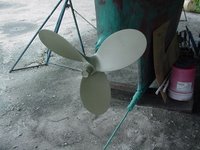 orkboats, ships, subs and can use 100% or more of the circle by using overlapping flukes.
orkboats, ships, subs and can use 100% or more of the circle by using overlapping flukes.Original 24"Prop of CSY
Since sailboats 'sometimes' really like to sail, 50 % surface area or less is the rule. I have seen smaller 3 blade power boat props
on an Antigua and the owner said it was fine. I've heard 20" for CSY's and believe their owners are happy. I have heard owners of max props, Martecs and auto props all tell of the great performance. Never, have I heard a complaint, about a change from CSY's 24", 50% sail prop design element, but the differences are very noticable. Martecs and Maxprops "flat blade" design can at best give you about 85% of the efficiency of a standard prop because the standard prop flukes are designed to create lift. You will never get the same speed 'motoring' with a feathering or folding prop, at the same rpms
 as you will with a properly pitched fixed prop. As one owner did, increasing his pitch from CSY 15" to 17", helps because that is a 13% boost in pitch. In calm water you can expect a boost from near 6kts. to near 7kts. With
as you will with a properly pitched fixed prop. As one owner did, increasing his pitch from CSY 15" to 17", helps because that is a 13% boost in pitch. In calm water you can expect a boost from near 6kts. to near 7kts. With 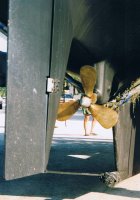 75 HP, you can repitch to 18". In choppy water you will still need diameter. Ten years ago, I installed a 24" Martec, 3 bladed feathering prop. It was great for sailing, but I lost a knot under power even though I tweaked it's external pitch adjustments.
75 HP, you can repitch to 18". In choppy water you will still need diameter. Ten years ago, I installed a 24" Martec, 3 bladed feathering prop. It was great for sailing, but I lost a knot under power even though I tweaked it's external pitch adjustments.Martec, 3 blade, feathering, 24" diameter propeller at left
3a. Fuel consumption. Much ado about nothing! I never heard of a Ferrari owner complaining about gas mileage, did you? Many owners have more into their boats than it would take to snap up a used Farrari, so come on. I put a grand a year into my boats tank (maybe) and alot more into my car. If an element like 1.5 gallons/hour or 2, or nail it to the wall for a few hours and burn 3, is really going to effect our cruising speed over time, then I'm talking to the wrong group!
3b. Engine life. I've had my boat 15 years and have put less than 2000 hours on. (True, I work on it too much and sail too little, but) I have traveled from the Chesapeake to Mobile along the coast. Around Florida a couple of times. Across the Gulf of Mexico to Pensacola a handful of times, up the Tombigbee waterway from Mobile, Alabama up to Kentucky, then all the way through the Cumberland River and Tennessee River, then back to do the Florida Keys a couple of times and yes some local daysailing. Fifteen years, less than 2000 hours. My old Lehman will last 15-50K hours without a rebuild, so I guess I'm good for another century if I keep spares:)
4. Parts. IF you wish to keep your engine, spend some time and you will locate a part, or rarely you can have something else made or adapted. If the engine is an antiquated design, using an engine that CSY used and built their stringers for, might simplify your hunt and reduce your cost. Ed Marill exchanged his engine for a totally rebuilt Perkins 4-236, 75 hp. for about $7000. if I remember correctly. No major projects like stringers to cut, extensive glass work, and adaptation of systems, transmissions or props. I've done them all. Ed did repitch his 24" CSY prop to 18" and was able to lower his rpms and gain hull speed while cruising. [ A 3" increase in pitch is a 20% increase. In theory, 20% more forward movement in the same period of time or RPM's. 6+ knots is now 7.5.] Later, he added a 23" Auto Prop and was very satisfied with it as well. Like probably most owners, Ed chose not to do the majority of work himself but to hire a pro for engine install. I'm guessing he laid out somewhere above $10,000 to complete the engine replacement/upgrade. I'm also guessing that total cost for an installation would run $20,000 for engine/material/labor on an engine install of a different configuration. Some of us are capable of doing our own work and finding good shops or outlets for parts, to keep costs down, but it is still a major task.
5. Yamaha. My 2 cents. Remember Evenrude, Johnson, Murcury? Sure they are still around but their marketing is not up the the imports. Maybe even their product is more similar to Chevy or Ford and thus are loosing the import battle, but certainly are not the Scott-Atwaters or Lawsons or Elgins of yester-year. Marketing is more decisive in how we now live than engineering. Sad.
Thirty some odd years ago, I was a marketing major so when I got an eye opener in St. Lucia, it all made too much sense.
We had been on charter and when leaving I asked the driver to detour if necessary to find a place to leave our extra food and supplies. I did not want them to be left for the Moorings community.
He drove to a small fishing village on the East coast of St. Lucia. Extremely poor town. We left the provisions with the church/shelter and the driver began to talk about the great thing Yamaha did for the town. They came in a donated brand new Yamahas to all the fishermen!
Yup. What a way to grab the market.
Don't get me wrong, Yamaha, like Hondas and Toyotas are great! Early on the Japanese imports were sold at or less than their American competion to gain market share, just as the relatively recent Hyundi. They last along time, but when you need a part, it's going to cost....especially without competition. Ok, enough on that, but it is important to know where you are going to live, cruise and what parts you might need.
6. Naturally Aspirated vs. Turbo. I'll try to let this beast sleep, but note the turbo discussion on the Topica site and others will get into "carbon build up, rebuilds, turbo failure and maintanace tasks". Do you methodically maintain everything aboard and would you 'like' to add this to the list?
7. Drive trains. It's a package. You can't put George Foreman's body on PeeWee Herman's legs! Same with engines and boats. The HP, Torque, RPMS, have to be matched to transmission Ratios and propeller Diameter and Pitch, to have the boat do what you want it to do. Increasing torque can give you the ability to add pitch. Just adding HP without changing final drive rpms, will basically keep you at the same speed, because the prop is going no faster. Adding HP and using it by moving more water is accomplished by changing transmission ratios or more easily, adding pitch to the prop. Decreasing prop size to save money or changing to a folding or feathering propeller will most always will not give you the surface area needed to propel the CSY in rough water as well as the std. size prop. Auto Prop, might be an exception.... Displacement vessels should restrict their final prop speed to between 700 and 1000 rpms to avoid slippage and cavitation. Gear accordingly. Adding HP might suggest changing the shaft strength(you cannot change diameter-you are limited to 1.5"). To do this, if you upgrade, Aquamet 22 stainless steel seems to be the recommended material. It is extremely corrosion resistant and formulated to take engine vibration. Aquamet 19 is similar but not as good with vibrations...fine for shafting a new rudder though.
8. Price. discussed above
9. Dig deeper. Ask, ask and ask again, dig deeper into the subject, until you really feel satisfied. It's certainly better than digging deeeeeeper into your pocket later.
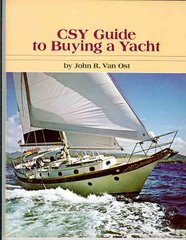
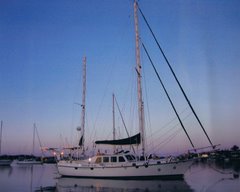
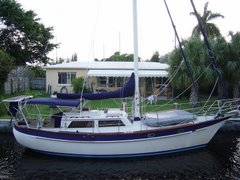
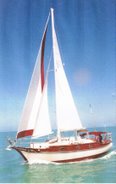
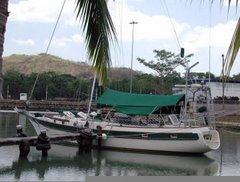
2 comments:
Hi Ron
First thank you for this very informative Blogg.
With a little luck I will be bringing home a 44 WO from Kentucky to the west coast of Florida, and saw that you have made the trip a few times.
Will she fit under all the bridge's taking the route to Mobile bay?
Thanks Clement
Clement, Sorry for late response. Just found it in my records.
WO's are normally 56' at mast top + antennas etc. When I drove Memory Rose up and back through the river systems I had removed my Main Mast and only left the Mizzen mast standing at 41'....so had no problem with any bridges. THAT was in 1997, so I'd recommend you contact the Corps. of Engineers to see what the bridge restrictions might be.
You can always have your mast pulled and rigged fore and aft on deck so you can take it with you...and can have it re-stepped in Mobile Bay.
It's a wonderful trip though! You will enjoy it!
Post a Comment